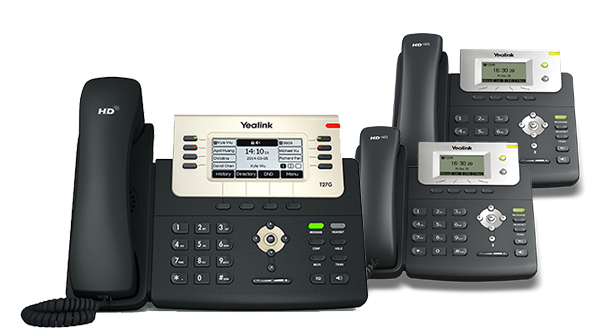Many CPAs are turning to the latest communications systems in order to communicate effectively with clients. VoIP, which stands for voice over internet protocol, is literally changing the way CPAs communicate.
So what’s all the buzz about? Tremendous cost savings, compared to traditional landline business phones; a plethora of features that landlines can’t offer; and the ability to work anywhere, while still using your business phone number.
This article will provide you with a clear understanding of why you should be considering switching to VoIP for your business communications needs. To download the free VoIP Guidebook, please click here for your copy: The Complete Guide to Switching to a VoIP Phone System.
VoIP – What is it exactly?
Voice over Internet Protocol phones use the internet to make and receive calls using analog or IP (Internet Protocol) phones that are plugged into Ethernet jacks.
VoIP differs from traditional landline phones because of technology. Landlines phones, which basically only let you receive or make phone calls, are basically the same as when they started at the turn of the 20th Century.
VoIP on the other hand has truly changed the way businesses now communicate, all due to technology innovation, coupled with internet speeds, which continue to become faster and faster
While traditional phones require that you pay added fees and costs for most features, with VoIP, you’ll enjoy a plethora of features that will transform your communications needs.
Business communications transformed
From a Virtual Receptionist, to Ring Groups, and the ability to work anywhere, VoIP has transformed the way businesses communicate. These powerful features will help your business make and create the impression you desire.
Let’s dive into a few of these features:
The Virtual Receptionist
How do you feel when you call a business and no one answers or they answer and you’re immediately put on hold? With VoIP, you won’t have to worry that callers will have that type of experience. When a live employee can’t answer the phone, Virtual Receptionist steps in, guiding the caller with a warm, welcoming greeting, giving callers the right options on how best to proceed to meet their needs.
Ring Groups
Ring Groups make sure that anyone who calls has their call answered by a live person. Ring Groups work in two different ways: Calls ring simultaneously, so everyone in a specific department – like sales or customer service – receives the call at the same time; or sequentially, ringing from one employee to another, until someone answers the call.
Work anywhere
Let’s face it, having employees use their personal phone numbers for business isn’t the most professional. And these days, employees are working remotely and on the go. Unlike traditional landlines, VoIP phone systems support employees working from anywhere – at home, while traveling, etc. – all through desktop and mobile apps.
Faxes
For many businesses, faxing is still very important. With VoIP, you can still send traditional faxes from your phone to a fax machine, and there’s Virtual Fax, removing the need for an actual fax machine, all together.
Phone number
Anytime you make a switch to a new phone system, one of the biggest concerns is can you keep your same business number. With VoIP, the answer is yes and easily. You just need to work through your VoIP provider who will take care of moving your business number to your new VoIP system. Once you plug your new phones in, you’ll be able to make and receive calls.
VoIP Systems – How they work
VoIP works by turning your voice into data, which is then transmitted over the internet. This is very similar to when you send an email.
In fact, you may have already used VoIP before if you’ve used Skype. To make a call on your phone, VoIP connects to the internet with a network cable or adapter, or via a computer’s microphone and speakers using an app. When making calls, the VoIP service provider routes the voice data between you and the other caller – all within a split second.
VoIP Systems – Key Advantages
The right impression
Whether your business has 5 or 100 employees, your company will make the right impression with a VoIP system, because these days callers’ interaction with you on the phone is critical.
Call quality
VoIP systems offer the call quality businesses desire, because of technology advances and increased internet speeds.
Cost savings
One of the biggest benefits businesses look for when switching from traditional landlines to a VoIP phone system are costs that are much lower. To find out what you could save by switching to VoIP, try the VoIP Savings Calculator.
Remote working
Unlike traditional landlines that don’t allow for remote working, VoIP provides the tools so any employee can work literally anywhere and stay in touch.
=========
Ken Narita’s marketing career spans two decades of helping businesses large and small grow. Whether advising emerging startups, guiding clients from the agency side or now leading SMB marketing at Ooma, Ken takes an empathetic approach to addressing goals, gaps, and opportunities. Ken has led demand generation, field marketing, customer marketing, and marketing operations teams, integrating campaigns across all functions to drive results. For questions or comments, please email: press@ooma.com. For more information about Ooma, visit us here: Ooma.
Thanks for reading CPA Practice Advisor!
Subscribe Already registered? Log In
Need more information? Read the FAQs
Tags: Benefits, Firm Management, Technology


![gavel1_11537663[1]](https://www.cpapracticeadvisor.com/wp-content/uploads/2020/03/gavel1_11537663_1_.5e6a69aa237a8.png)

